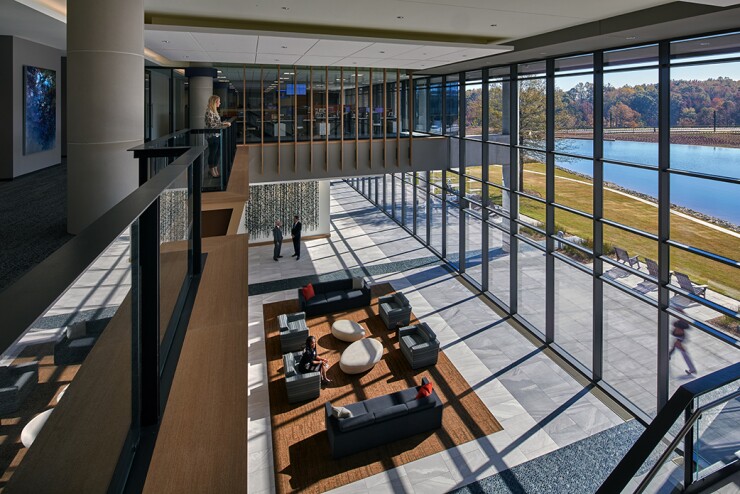While companies like Google and Facebook are usually lauded for redefining office space, other employers have taken notice and are reaping the benefits.
Wellness architecture, the new phenomenon of building workspaces with health and
“A lot of clients that are looking to make big changes are doing it because the cost of real estate is so high,” says Burt Rea, managing director for Deloitte Consulting. “In yesterday's office designs, a lot of office space went vacant.”
Flexible workspaces are a major departure from the standard office cubicles and workplace experts believe that they are becoming the de facto setting for hybrid workplaces, which are primarily communal spaces with conference and private rooms that employees can access at their choosing.
Rather than being segregated by departments, employers can leverage technology, such as organizational network analysis (ONA), to help employees work amongst their peers and increase productivity, Rea says.
ONA uses analytics to scan employees’ e-mails, instant messages and physical proximity to determine who works with whom, and can then determine teams within the company, according to a recent global human capital 2017
For employers who want to maximize profitability, ONA can suggest to employees where and with whom to work with on any given day, says Rea.
One of the companies that uses ONA saw total revenue generation rise by more than 12% since implementing a team-centric model, according to the Deloitte report.
Through ONA, Deloitte has been “able to see which types of interactions absolutely need to be in person and which ones need to be enabled by conference calling,” says Rea. “There’s lots of different ways to enable teams to work together.”
While employers can set up an open floor plan and ONA, others can be limited by the building design and might need to turn to vendors to fill in the gaps, like access to natural light.
“Studies indicate natural light is an enabler of wellness, an enabler of creativity and an enabler of feeling good about the place you work,” says Rea.
LED light bulbs “deliver a biologically-optimized spectrum of light for every time of the day — on demand, according to Lighting Science Group Corp., a Rhode Island-based lighting company. The lights work with employees’ circadian rhythms to achieve peak productivity, which is a challenge for office spaces without adequate natural lighting.
See also:
Other technologically-enabled options include installing LED light bulbs into smart devices that will dim when the sun is at its peak, which cuts down on energy costs, and smartphone apps that allow employees to change the temperature or lighting with the tap of a finger.
Planning a more inviting office
It requires significant planning and upfront costs to transform an office floor or build a new building altogether, which is what LPL Financial did.
The nation's largest independent broker-dealer unveiled its 27-acre Carolinas campus, in Fort Mill, South Carolina, last November. The two

Before building the campus, LPL Financial surveyed employees on the location and amenities required for an ideal work-life balance, as well as the level of engagement employees want from their workspace, says Sara Nomellini, senior vice president of corporate real estate at LPL Financial.
“The location, suburban versus downtown, was based on the need to be flexible in our portfolio,” she says. “Because of that, we needed a flexible footprint, which in essence drives a campus setting. I can add or remove pieces of the portfolio as need be.”
The campus sits adjacent to the 2,100-acre Anne Springs Close Greenway nature preserve, where more than 1,400 employees have access to two miles of walking trails and a boardwalk with open air lounge spaces, various seating options and Wi-Fi access; outdoor sports courts and community gardens are also on the campus.
“It's important to let [employees] know that we view them as our most important asset,” says Nomellini. “We’re concerned about your overall wellness. We’ll do everything we can to assist that. We trust you to use your time well and take
Since October, the company has hired 246 employees. The state will also give future tax credits to the company based on the number of employees LPL Financial hires.
Because LPL Financial has been in the building for about five months, Nomellini says she doesn’t have any data on how cost efficient the building is just yet. LPL Financial would also not disclose the cost of the building, but the company did receive $2 million from the state for construction costs, according to the Charlotte Observer.
However, Nomellini says the prospect of cost-saving measures through wellness architecture has created “a big buzz in my professional community.”
“How do you actually prove that?” she says. “The only way you can do that is measure
Deloitte’s clients were primarily trying to capture the real estate costs and found employee productivity, collaboration, innovation, engagement,
“Companies are trying to reach an employee audience, another talent group,” he says. “We need to create a workspace that can attract the kind of digital, high-tech talent to be competitive.”
Nomellini agrees.
“It’s not even a choice anymore, especially with the market being so competitive for employee talent,” she says. “If you're an employer and you want good talent, you don't have a choice.”





